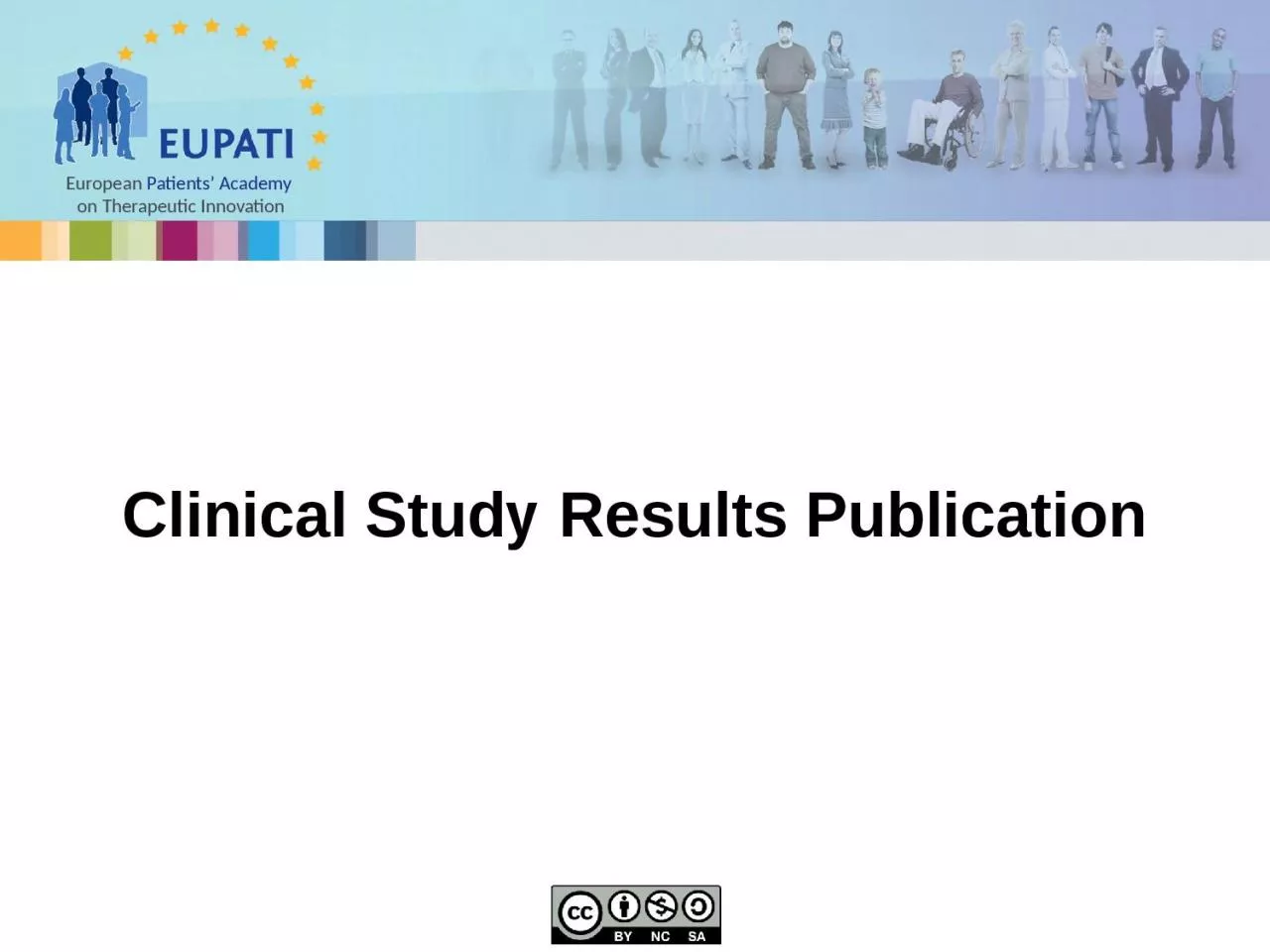

Clinical trials are required in the development of new medicines and improved treatments for patients The information that clinical trials generate on the efficacy and safety of treatments ID: 1012069
Download Presentation The PPT/PDF document "Clinical Study Results Publication" is the property of its rightful owner. Permission is granted to download and print the materials on this web site for personal, non-commercial use only, and to display it on your personal computer provided you do not modify the materials and that you retain all copyright notices contained in the materials. By downloading content from our website, you accept the terms of this agreement.
1. Clinical Study Results Publication
2. Clinical trials are required in the development of new medicines and improved treatments for patients. The information that clinical trials generate on the efficacy and safety of treatments is important for patients and their doctors to make informed treatment decisions. The utility of a treatment must be assessed globally, taking all the results available from clinical trials investigating the treatment into consideration. 2Clinical Study Results
3. Access to information on clinical trials is one important way for improving efficiency in research by reducing duplication of research efforts.The transparency of clinical trial information is important in ensuring trust in clinical trial results. The reader will have to critically review the information published on clinical trials.3Access to Information
4. The results of a clinical study or trial are all the data, measures, and statistical analyses generated during that clinical trial or study including:Baseline data: Data collected at the beginning of a clinical study. These data include demographics (such as age and gender), patient characteristics (such as weight, height, blood pressure, etc.), and study-specific measures (such as disease characteristics or prior treatment).4Study Results
5. Measures capturing the effect of the treatment on participants: For example, medicine activity in a Phase II trial, patient survival and/or quality of life, change in disease parameters in Phase III trails. Adverse events experienced by the participants: For example, pain, nausea, and other side effects.Description of the study sample (important for analysis):The number of participants per study treatment arm who started, completed, or dropped out of the study.5Study Results
6. The Clinical Study Report (CSR) is the formal document describing the results of a clinical study and provides evidence for a medicine’s use in humans. CSRs follow a format laid down by the regulatory authorities. The CSR is prepared by the study sponsor and forms part of the Common Technical Document (CTD). Access to clinical study reports is usually limited to the sponsor and the regulatory authorities assessing a Marketing Authorisation Application (MAA), due to confidentiality and commercial reasons.6The Clinical Study Report (CSR)
7. 7Publication of Clinical Trial ResultsAt the end of the clinical study and its analysis, researchers may present their conclusions at scientific meetings and in medical journals. Before publication in medical journals, the manuscript is peer-reviewed by independent experts appointed by the journal editor.Publications should contain enough details to enable the reader to make their own judgement about the study findings.
8. The confidence that a reader has in the validity of the results is influenced by the quality of the publication.Therefore, various guidelines and checklists are available to guide the reporting of results in a standardised way, depending on the type of research being performed.8Publication of Clinical Trial Results
9. Various organisations are engaged in initiatives to encourage or require the registration and disclosure of clinical trial information. In Europe, the EU Clinical Trials Register allows searches to be made for protocol and results information contained in the EudraCT (the European Clinical Trials Database), a database of all interventional clinical trials which commenced in the Community from 1st May 2004, and also includes clinical trials conducted outside the EU linked to European paediatric medicine development.9Information on Clinical Trials
10. For trials taking place in the EU starting after 1st January 2015, the results must be published whether they are negative or positive. The World Health Organisation (WHO), through its International Clinical Trials Registry Platform (ICTRP) http://www.who.int/ictrp/en/, is setting international standards for registering and reporting on all clinical trials. In the US, the registry clinicaltrials.gov is taking a similar approach.10Information on Clinical Trials
11. Levels of evidence represent and classify the quality of the study and therefore the strength of the evidence that the study provides. Randomised, controlled, blinded studies provide the best scientific evidence of benefit and risk, but are not always available. Levels of evidence used should be considered when reading clinical trial results publications. 11Levels of Evidence
12. 12Levels of Evidence
13. In general, the types of studies are:Adequately powered, high-quality randomised trials, or meta-analysis of randomised trials showing statistically consistent results;Randomised trials inadequately powered, possibly biased, or showing statistically inconsistent results;Non-randomised studies with concurrent controls;Non-randomised studies with historical controls (for instance, a typical single-arm Phase II study);Expert committee review, case reports, retrospective studies.13Levels of Evidence
14. The risk of misuse and misrepresentation of statistical tests and their outcomes due to the confusion about the meaning of numbers (estimates) and the interpretation of hypothesis tests (p-values, power).14Sources of Errors in Publications
15. testing large numbers of hypotheses in a single data set in search for a positive effect. When numerous hypotheses are tested with a single data set, it is virtually certain that some hypotheses will appear falsely as statistically significant. If researchers using data-mining techniques are not cautious, they can be easily misled by these apparently significant results.15Data Dredging
16. in research, bias occurs when systematic error is introduced into data sampling or hypothesis testing by selecting or encouraging one outcome or answer over others.Bias is not always the result of intentional actions – it can also be unintentionally introduced.16Bias
17. Goldacre, B. (2010) Bad science: Quacks, hacks, and big pharma flacks. New York: Faber and Faber.Rennie, D., & Guyatt, G. (2002). Users' guides to the medical literature: A manual for evidence-based clinical practice. Chicago, IL: American Medical Association.17References